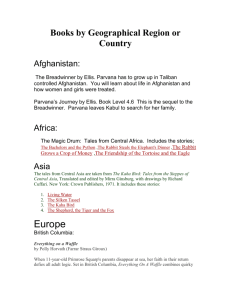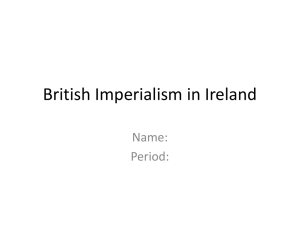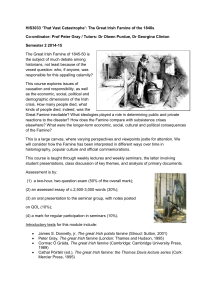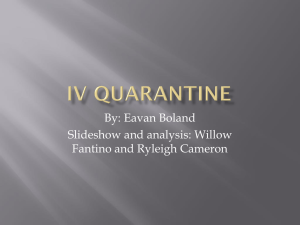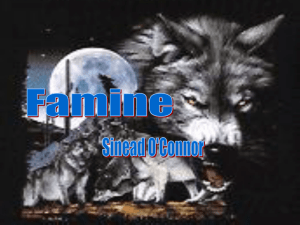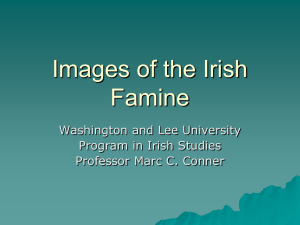- Worlds of Words
advertisement
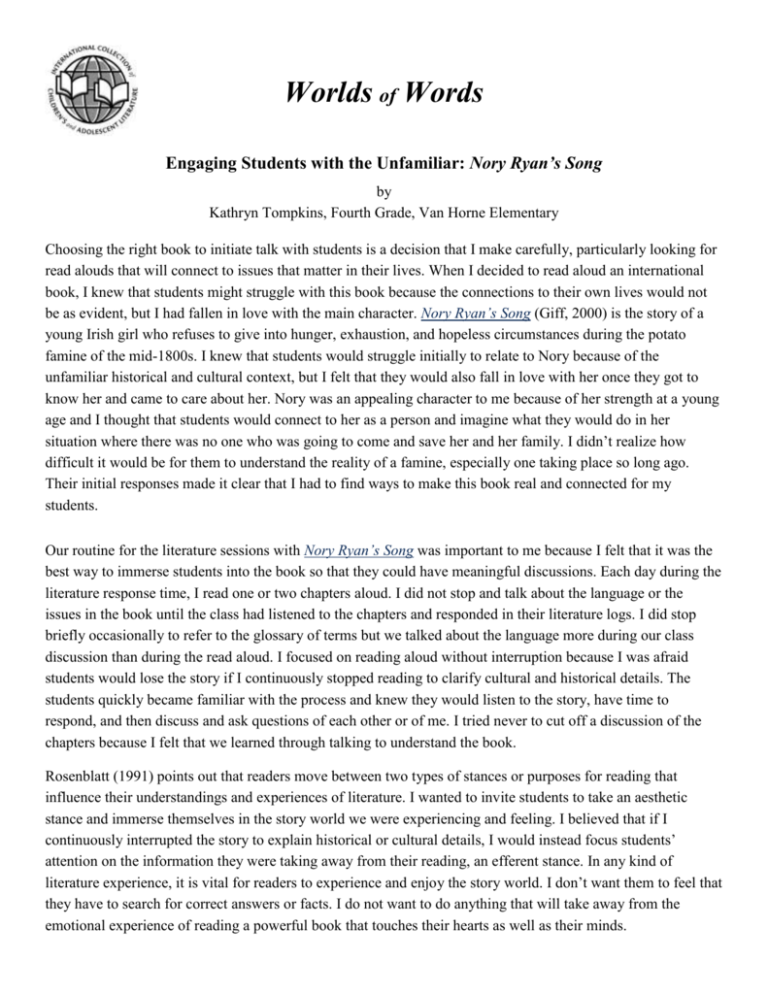
Worlds of Words Engaging Students with the Unfamiliar: Nory Ryan’s Song by Kathryn Tompkins, Fourth Grade, Van Horne Elementary Choosing the right book to initiate talk with students is a decision that I make carefully, particularly looking for read alouds that will connect to issues that matter in their lives. When I decided to read aloud an international book, I knew that students might struggle with this book because the connections to their own lives would not be as evident, but I had fallen in love with the main character. Nory Ryan’s Song (Giff, 2000) is the story of a young Irish girl who refuses to give into hunger, exhaustion, and hopeless circumstances during the potato famine of the mid-1800s. I knew that students would struggle initially to relate to Nory because of the unfamiliar historical and cultural context, but I felt that they would also fall in love with her once they got to know her and came to care about her. Nory was an appealing character to me because of her strength at a young age and I thought that students would connect to her as a person and imagine what they would do in her situation where there was no one who was going to come and save her and her family. I didn’t realize how difficult it would be for them to understand the reality of a famine, especially one taking place so long ago. Their initial responses made it clear that I had to find ways to make this book real and connected for my students. Our routine for the literature sessions with Nory Ryan’s Song was important to me because I felt that it was the best way to immerse students into the book so that they could have meaningful discussions. Each day during the literature response time, I read one or two chapters aloud. I did not stop and talk about the language or the issues in the book until the class had listened to the chapters and responded in their literature logs. I did stop briefly occasionally to refer to the glossary of terms but we talked about the language more during our class discussion than during the read aloud. I focused on reading aloud without interruption because I was afraid students would lose the story if I continuously stopped reading to clarify cultural and historical details. The students quickly became familiar with the process and knew they would listen to the story, have time to respond, and then discuss and ask questions of each other or of me. I tried never to cut off a discussion of the chapters because I felt that we learned through talking to understand the book. Rosenblatt (1991) points out that readers move between two types of stances or purposes for reading that influence their understandings and experiences of literature. I wanted to invite students to take an aesthetic stance and immerse themselves in the story world we were experiencing and feeling. I believed that if I continuously interrupted the story to explain historical or cultural details, I would instead focus students’ attention on the information they were taking away from their reading, an efferent stance. In any kind of literature experience, it is vital for readers to experience and enjoy the story world. I don’t want them to feel that they have to search for correct answers or facts. I do not want to do anything that will take away from the emotional experience of reading a powerful book that touches their hearts as well as their minds. Worlds of Words Worlds of Words Students had small literature logs to respond in after each read aloud. They responded through writing their thoughts and questions or sketching for five minutes and then we discussed the book as a class. At the beginning of the book their responses were narrow and surface-level. In their logs, I saw entries saying that “Nory has a friend named Shawn,” or “Nory’s dad went fishing.” Students were just skimming the surface of the book to note information but not trying to understand the characters and their situations. They were bored by the idea of this young girl starving in Ireland because they didn’t believe that it could happen or thought it was a problem that could be easily solved. One student asked, “Why didn’t the U.S. go help them?” Students saw the U.S. as having a mission to go into other countries and save them from their problems. They wanted to know why no one went to the aid of the Irish and why England would continue to charge rent to starving people and throw them out of their homes. It seemed strange to them and these tensions led them to become a little more engaged in the book. I didn’t have to work at interesting students in the language of the characters. They began using fuafar in reference to anything they felt was disgusting. They loved calling dogs madras. The most intriguing part of the language for them was the reference to sidhe, creatures from another world who cause trouble. They talked about how people carried salt to protect themselves and how the horrible sidhe liked to steal boys. They were particularly fascinated that Nory’s little brother, Patch, wore a gown rather than pants to fool the sidhe into thinking he was a girl because he would be stolen if they saw he was a boy. They were fascinated by these spirits and the idea that the night belonged to them so that children had to be careful when they left the house after dark. They used vocabulary from the book in their writing and class discussions. The author does a great job of including Irish words that are easy for students to remember and process in their talk. She doesn’t overwhelm readers with lots of terms that would cloud their understanding but has carefully selected key terms that give a flavor of the language and culture. One strategy that helped students understand the context of the book was to show them maps of Ireland. Most of the students had heard of Ireland but they didn’t know anything about it. They had no idea where it was located or what surrounded it. The book said that Nory’s family and other Irish people were trying to get to the port of Galway to board ships to other countries. We found Galway on a map and that helped them realize that the book was set in a real place with real issues and real people. If Galway was a real place, then people like Nory must have existed. I found it was important to look at maps and other reference books at a separate time from our read aloud and discussion of Nory Ryan’s Song. The time we spent reading and discussing Nory was used only for reading and discussing the book, not for lessons about Ireland. I scheduled other times throughout the day to look at maps and discuss books on Ireland to learn more about the place where Nory lived so that they would have more background knowledge on the place and time. I didn’t want students to get caught up in the details of Ireland when we were discussing Nory’s life. Worlds of Words Another strategy that helped students better understand the time period was to find books dealing with the potato famine. It seemed difficult for my class to understand the severity of the potato famine from 1845-1850. I checked out books on Ireland and the potato famine that they could browse and they read about and saw the destruction caused by the rotting potatoes. They wanted to learn more about this time and they were eager to find more information, so much so that they started doing their own internet research. Whereas they initially saw potatoes as an occasional food to eat, they came to realize that the potato was a staple for the Irish, not only as food but as future income. Potatoes were the livelihood for the Irish farmers. In Black Potatoes (Bartoletti, 2001), the students learned the details of this famine and it became real to them. The fact that one million people died due to starvation and disease over a five-year famine came to mean something. The book had illustrations that helped students picture the time when Nory lived. This made her more relatable to the students, despite her “living” over 150 years ago. The history came alive as a real time with real consequences due to the loss of potatoes. Their initial thoughts were, “Okay, the potatoes are rotten so go to the store.” After doing research on the 1840s in Ireland, they understood there were no stores or trees full of fruits, just potatoes. No potatoes meant no food. I noticed the point when they understood the difference in the way that Nory lived by the entries in their literature logs. At first they saw famine as meaning a person was hungry with a growling stomach. As Brianna’s Worlds of Words log shows, she thought they “hardly had food” and so their stomachs started growling. As she grew to understand what a famine really was, she drew tombstones for those who died and a young boy who is so hungry he moans for potatoes in his dreams. The research into the time period in Ireland and the illustrations in the books helped students understand the difference between having a stomach growl from hunger and really starving due to famine. Looking back I realize that another strategy was taking time each day to discuss with students and talk through their understandings of the chapters we were reading. I could tell from their literature logs when they started connecting to the story. Each day during discussion they talked through the issues and questions they had about the book. They challenged each other and tried to answer their questions. They also expressed their frustrations with what they didn’t understand. This time to engage in talk became an important strategy for them to work out new understandings about the book. Their talk also helped me to know what resources to seek out. The fact that they were stunned by the idea of a famine told me that I needed background materials on the potato famine. Listening to their talk helped me plan ways to help them better understand the book. ne student, Maya, who loves to read and usually connects to stories read aloud in class, struggled at the beginning of the book. She felt sad for Nory but didn’t see the characters as real people dealing with the unimaginable issue of famine. Once we learned more about the famine through books and internet research, she came to see the characters in Nory Ryan’s Song as real people. She felt hate for the English landlords who took away the animals and the homes of the Irish people. She was so angered by this situation that she fixated on the landlord during class discussions. We had to talk about that, just because the mean landlord was English, it didn’t mean that all of the English were the same. There are people in America who make bad choices but that doesn’t make all Americans bad. The book evoked powerful feelings in the children. By the end of Nory Ryan’s Song, the students were hooked! They felt as if she was a friend and cared about what was going to happen to her. I had become a fan of all three Nory books—Nory Ryan’s Song, Maggie’s Door, and Water Street—and made the decision to continue my literature time using Maggie’s Door because I knew how invested the students had become in Nory. I felt that we had moved over the hurdle of finding something in the book to connect to because the students understood the famine and how life was for the Irish during this time period. The day that we finished Nory I watched and listened as they discussed her future and stressed about what would happen to her. When I told them that they would continue to learn about Nory they begged me to start reading Maggie’s Door immediately. I had never seen students so excited about a book! Who would have guessed how strongly they would identify with a young girl who lived so long ago! We sailed through Maggie’s Door, reading at least one or two chapters a day, and they continued to fret about Nory making her way to the U.S. They fell in love with Nory and with Shawn and wanted the “American Dream” for them. Maggie’s Door ends with Nory and Shawn seeing the Statue of Liberty from their ship and reuniting with Worlds of Words members of their families. The students knew that this couldn’t be the end! I started Water Street the same day we finished discussing Maggie’s Door. When I read the first chapter, the students were crushed that Nory was all grown up and that this book focused on her daughter. They were frustrated because they had grown to love Nory as a young girl whom they could identify with. They gave Bird, Nory’s daughter, a chance simply because she was Nory’s daughter, and did learn to love her as well. The author of these books, Patricia Reilly Giff, did an amazing job of creating characters who students could come to know and love and want to identify with, despite the differences in their lives and situations. Nory Ryan’s Song became the standard for my students in judging other books. They constantly compared other characters and books to Nory Ryan’s Song and worked at understanding historical events in other countries by connecting those events to Nory. This book was definitely our “touchstone” book for the year. I also learned more about how to get my students to invest in a book that is set in a different time period and cultural and geographical context. Pick a book with a strong character to whom students can relate. Provide background information using maps, books, or internet research. Don’t interrupt the reading of the book to give informational lessons. Let them discuss! They can learn so much from each other through talk. Reading through all three books was a tremendous investment of time, but the depth of what students came to understand about Irish culture and their strong sense of commitment and connection to Nory made that time well worthwhile. They continued reading and rereading these three books, checking them out of the library for their personal enjoyment. Nory had become a significant person in their lives with whom they had a relationship across time and place and Ireland was no longer a name on a map but the home of a friend. Reference Bartoletti, S.C. (2001). Black potatoes. New York: Houghton Mifflin. Giff, P.R. (2000). Nory Ryan’s song. New York: Scholastic. Giff, P.R. (2003). Maggie’s door. New York: Wendy Lamb. Giff, P.R. (2006). Water Street. New York: Wendy Lamb. Rosenblatt, L. M. (1991). Literature- S.O.S.! Language Arts, 68, 444-448.
